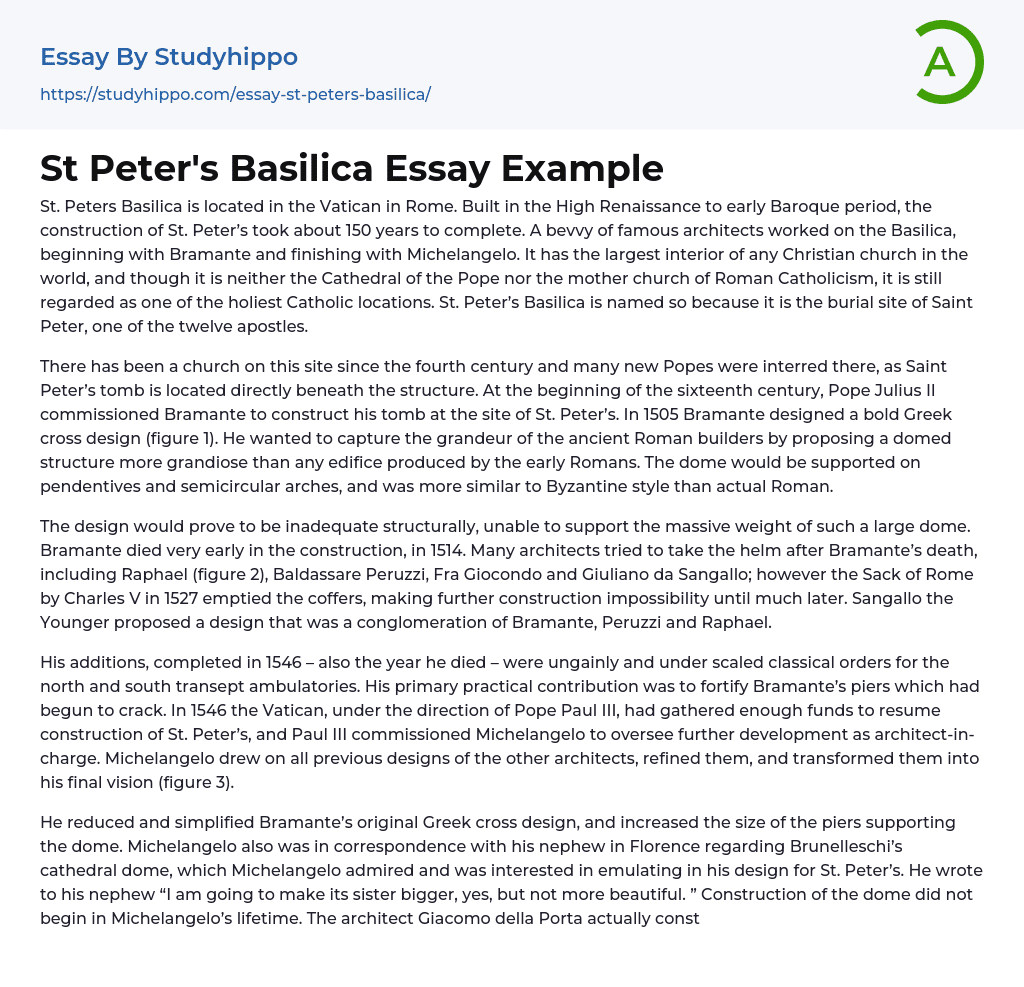St. Peters Basilica is located in the Vatican in Rome. Built in the High Renaissance to early Baroque period, the construction of St. Peter’s took about 150 years to complete. A bevvy of famous architects worked on the Basilica, beginning with Bramante and finishing with Michelangelo. It has the largest interior of any Christian church in the world, and though it is neither the Cathedral of the Pope nor the mother church of Roman Catholicism, it is still regarded as one of the holiest Catholic locations. St. Peter’s Basilica is named so because it is the burial site of Saint Peter, one of the twelve apostles.
There has been a church on this site since the fourth century and many new Popes were interred there, as Saint Peter’s tomb is located directly beneath the structure. At the b
...eginning of the sixteenth century, Pope Julius II commissioned Bramante to construct his tomb at the site of St. Peter’s. In 1505 Bramante designed a bold Greek cross design (figure 1). He wanted to capture the grandeur of the ancient Roman builders by proposing a domed structure more grandiose than any edifice produced by the early Romans. The dome would be supported on pendentives and semicircular arches, and was more similar to Byzantine style than actual Roman.
The design would prove to be inadequate structurally, unable to support the massive weight of such a large dome. Bramante died very early in the construction, in 1514. Many architects tried to take the helm after Bramante’s death, including Raphael (figure 2), Baldassare Peruzzi, Fra Giocondo and Giuliano da Sangallo; however the Sack of Rome by Charles
V in 1527 emptied the coffers, making further construction impossibility until much later. Sangallo the Younger proposed a design that was a conglomeration of Bramante, Peruzzi and Raphael.
His additions, completed in 1546 – also the year he died – were ungainly and under scaled classical orders for the north and south transept ambulatories. His primary practical contribution was to fortify Bramante’s piers which had begun to crack. In 1546 the Vatican, under the direction of Pope Paul III, had gathered enough funds to resume construction of St. Peter’s, and Paul III commissioned Michelangelo to oversee further development as architect-in-charge. Michelangelo drew on all previous designs of the other architects, refined them, and transformed them into his final vision (figure 3).
He reduced and simplified Bramante’s original Greek cross design, and increased the size of the piers supporting the dome. Michelangelo also was in correspondence with his nephew in Florence regarding Brunelleschi’s cathedral dome, which Michelangelo admired and was interested in emulating in his design for St. Peter’s. He wrote to his nephew “I am going to make its sister bigger, yes, but not more beautiful. ” Construction of the dome did not begin in Michelangelo’s lifetime. The architect Giacomo della Porta actually constructed the dome, and made some changes to the design for practicality.
He created a taller profile, reducing lateral thrust that would have been difficult for a masonry drum to withstand. Eventually a nave was added by Carlo Maderno and this reduced the impact of the height and massiveness of Michelangelo’s dome. During the counter-reformation the Catholic Church was greatly discouraging dissent and wanted artists/architects to return to glorifying
images of the faith and the church. The church used Baroque architecture, such as St. Peter’s, to demonstrate the splendor and grandeur of the church as a way of welcoming the wayward back into the fold as well as reaffirming the conviction of the faithful.
- Arch essays
- Area essays
- Architecture essays
- Design essays
- Graffiti essays
- Graphic essays
- Interior design essays
- Painting essays
- Photography essays
- Sculpture essays
- Typography essays
- Adam And Eve essays
- Baptism essays
- Catholic Church essays
- Christian essays
- Church essays
- Crucifixion Of Jesus essays
- Crusades essays
- Elizabeth essays
- Eucharist essays
- God The Father essays
- Holy Spirit essays
- Jesus Christ essays
- Lord essays
- Pope essays
- Priest essays
- Protestant Reformation essays
- Protestantism essays
- Sacrament essays
- Frida Kahlo essays
- Michelangelo essays
- Pablo Picasso essays
- Vincent Van Gogh essays
- Athens essays
- Belgium essays
- Berlin essays
- British essays
- England essays
- Germany essays
- Great britain essays
- Greece essays
- Ireland essays
- Italy essays
- London essays
- Paris essays
- Pompeii essays
- Rome essays
- Russia essays
- Spain essays
- United Kingdom essays




